The Coso Artifact
In 1961, Wally Lane, Mike Mikesell and Virginia
Maxey, co-owners of the LM&V Rockhounds Gem and Gift Shop in
Olancha, California, went into the Coso Mountains to look
for unusual rocks. They found a fossil-encrusted geode on
February 13, 1961, on a mountain peak 4,300 feet high, about 340
feet above the dry Owens Lake, six miles northeast of Olancha.
Geologists estimate that about 10,000 years ago, Owens Lake was
as high as the top of the peak.
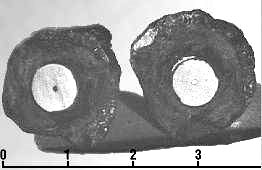 After
Mike Mikesell had ruined a diamond saw blade in cutting
it open, the geode proved to contain something strange.
In the middle of the geode was a metal core, about .08
inch (2 millimeters) in diameter. Enclosing the core was what
appeared to be a ceramic collar that was itself encased
in a hexagonal sleeve carved out of wood that had, presumably at
a later date, become petrified. Around the petrified wooden
enclosure was the outer layer of the geode, consisting of
hardened clay, pebbles, bits of fossil shell, and two
nonmagnetic metallic objects resembling a nail and a
washer.
After
Mike Mikesell had ruined a diamond saw blade in cutting
it open, the geode proved to contain something strange.
In the middle of the geode was a metal core, about .08
inch (2 millimeters) in diameter. Enclosing the core was what
appeared to be a ceramic collar that was itself encased
in a hexagonal sleeve carved out of wood that had, presumably at
a later date, become petrified. Around the petrified wooden
enclosure was the outer layer of the geode, consisting of
hardened clay, pebbles, bits of fossil shell, and two
nonmagnetic metallic objects resembling a nail and a
washer.
A fragment of copper still
remaining between the ceramic and the petrified wood suggests
that the two may once have been separated by a now decomposed
copper sleeve. Later, the x-ray of the object would reveal a
shape resembling a spark plug, according to the editor of
INFO Journal (International Fortean Organization),
Paul Willis. Based on an approximate stratification and the
composition of the outer crust, the object has been dated from
250,000 to 500,000 BCE, but the name of the geologist who
provided the dating is not mentioned in any source material.
A member of INFO visited Maxey and Lane. Maxey
stated that the object isn’t magnetic now (article printed in
1969), but she apparently said it was magnetic in a February,
1961 article in Desert Magazine. An INFO article
concluded with the statement that no professional scientist has
ever investigated the artifact, and that the owners are asking
an exorbitant payment before they’ll let anyone examine it.
If we assume that it is an alien artifact, or something left
over from an advanced ancient culture and not just a fossil
encrusted spark plug, what might it be? The construction is
reminiscent of modern attempts at superconductors. If
anyone would try to replicating the object using ceramic
superconductors and then cooling it off with liquid nitrogen, it
might be interesting to see what happens...
Batteries of Babylon
In 1938, Dr. Wilhelm Kong, an Austrian archaeologist
rummaging through the basement of the museum, made a find that
was to drastically alter all our concepts of "ancient
knowledge." A 6-inch-high pot of bright yellow clay
dating back two millennia contained a cylinder of sheet-copper 5
inches by 1.5 inches. The edge of the copper cylinder was
soldered with a 60-40 lead-tin alloy comparable to today’s
solder. The bottom of the cylinder was capped with a crimped-in
copper disk and sealed with bitumen or asphalt. Another
insulating layer of asphalt sealed the top and also held in
place an iron rod suspended into the center of the copper
cylinder. The rod showed evidence of having been corroded with
an acidic agent. With a background in mechanics, Dr. Konig
recognized this configuration was not a chance arrangement --
the clay pot was nothing less than an ancient electric
battery.
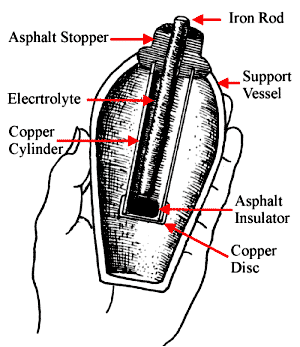 The
ancient battery in the Baghdad Museum, as well as those
others which were unearthed in Iraq, are all dated from
the Parthian occupation between 248 BCE and 226 CE. However,
Dr. Konig also found copper vases plated with silver in the
Baghdad Museum, excavated from Sumerian sites in southern
Iraq, dating back to at least 2500 BCE. When the vases
were lightly tapped, a blue patina or film separated from the
surface, which is characteristic of silver electroplated onto
copper base. It would appear then that the Parthians
inherited their batteries from one of the earliest known
civilizations.
The
ancient battery in the Baghdad Museum, as well as those
others which were unearthed in Iraq, are all dated from
the Parthian occupation between 248 BCE and 226 CE. However,
Dr. Konig also found copper vases plated with silver in the
Baghdad Museum, excavated from Sumerian sites in southern
Iraq, dating back to at least 2500 BCE. When the vases
were lightly tapped, a blue patina or film separated from the
surface, which is characteristic of silver electroplated onto
copper base. It would appear then that the Parthians
inherited their batteries from one of the earliest known
civilizations.
Several years ago, a theory was proposed that
electrolyte-crushed wine grapes may have been used. It was put
to the test with a positive result--a replica of the Baghdad
cell generated 0.87V. Several cells, in serial arrangement, were
sufficient for the electroplating of small objects.
It also seems that the use of similar batteries can be safely
placed into ancient Egypt, where several objects with
traces of electroplated precious metals have been found at
different locations. There are several anomalous finds from
other regions, which suggests use of electricity on a grander
scale. One of them is the girdle from the tomb of Chinese
general Chu (265-316 CE), which is made from an alloy of 85%
aluminum with 10% copper and 5% manganese. The only viable
method of production of aluminum from bauxite is electrolytic
process, after alumina (aluminum chloride component of the
ore) is dissolved in molten cryolite, patented in the
middle of last century. Needless to say, the Baghdad type of
batteries would not suffice, for quite a substantial
dynamo-generated current is needed.
Dendera Glyphs, Djed, Ankh and
Staff-Scepter
At the Hathor Temple in Dendera, Egypt, several
intriguing glyphs are depicting strange scenes. In the opinion
of a classical archeologist, there is hardly anything out of
ordinary in the scenes, as ascertained by Dr. John Harris
of Ashmolean Museum of Oxford University, upon an enquiry from
Janet Gregory, a Representative of
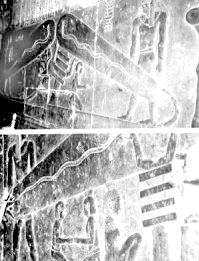 SITU
in England.
SITU
in England.
"...The objects represent an
elaborate form of the snake-stones—(granite) stelae with
snakes on them—discussed by H. Kees in "Die
Shclangensteine und Ihre Besiehungen zu den
Reichsheiligrumern, Zeitschrift für Aegyptishe Sprache",
LVII (1922) , p. 120-136. Their precise significance is
difficult to summarize in brief, since in the course of time
they acquired a wealth of religious associations, but
essentially, they were apropraic in character, e.g., as
guardians of doorways (in much the same way as obelisks
and flagstaves). I append what Kees has to say
about the scene in question*
and the one parallel to it... from which you see that the
stones here are connected with Horus ’sma-tawy’ (Uniter
of Two Lands), to whom the accompanying inscription
refers. The objects supporting the stones, are incidentally,
djed-pillars (symbolic of stability), and the
double outlining of the larger figures is simply to indicate
that there are two of them standing side-by-side.
*Yet it is possible to
establish that the Snake (god) Patrons, whenever they
appear prominently such as in Dendera, are definitely
connected in the mythological sense with the identity of
Harsomtus. He was obviously a genius of the art [of the
snake cults] since he is so often mentioned in Dendera in
relation to these. Harsomtus’ connection with the snake
cult is further established by other pictures of him in
the form of a aptron climbing out of a lotus blossom—a
religious motif forming, no doubts, the basis for the glyphs
of the ’snake stones’. The close proximity of the
gods of the Suns and the Heavens are undoubtedly responsible
for the origin of the Snake-Stone tablets, the artist being
fully aware of the ancient concepts of the signs for
Patrons pro or con the god Horus."
Well... very nicely put, at least
from an egyptologists’ point of view. These snake-stones
may have been set up on either side of entrances to temples or
rooms assigned for the snake cult, supported by the symbols of
stability, djed pillars, and held in place by priests. On
the other hand, Ivan Troëng, a Swedish writer, was
apparently not well read in the egyptology materials. In a book
Kulturer Føre Istiden, 1964, he captioned a reproduction
of the Dendera wall with the objects in question as:
"The picture from Hall 5 [sic]
of the Dendera Temple obviously shows electric lamps held by
high-tension insulators".
The explanation of the glyphs
stirred some passion amongst amateurs and experts alike. But
then something curious happened: the book got noticed by
electrical engineers. As a group of professionals who could
not care less about what other experts think, they commented on
the picture with an unequivocal ’wow!’. When shown the
archeology experts’ explanation of the glyphs, they found it
simply hilarious, according to Ivan Sanderson’s
Investigating the Unexplained.
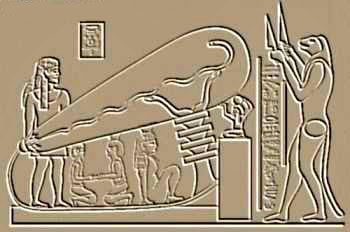 Let’s
assume for a moment that the egyptologists’ explanation,
hilarious or not, is correct. It can be argued that ancient
Egyptians were very meticulous and pragmatic as far as their
recordings were concerned. There was not much room for artistic
license, bare the ability to arrange hieroglyphs in the most
esthetic and space-conserving way. Their canon specified
precisely how certain things and their relationship must be
presented, as is apparent on the relationship reflected in the
depiction of gods, kings and common people, according to their
importance.
Let’s
assume for a moment that the egyptologists’ explanation,
hilarious or not, is correct. It can be argued that ancient
Egyptians were very meticulous and pragmatic as far as their
recordings were concerned. There was not much room for artistic
license, bare the ability to arrange hieroglyphs in the most
esthetic and space-conserving way. Their canon specified
precisely how certain things and their relationship must be
presented, as is apparent on the relationship reflected in the
depiction of gods, kings and common people, according to their
importance.
The glyphs in Dendera strike
me as odd in this context. You will notice that the depiction of
Horus is rather small in comparison with people under the
snake-stone, and the largest figure in the picture is not the
priest (and even if there are two of them, holding the diorite
stone of that size would be quite a feat), but the monkey with
knives. The monkey represents in a symbolic form danger for the
uninitiated. As it is the most prominent figure in the
depiction, we have to assume that the danger inherent in the
activity (whatever it was) must have been considerable.
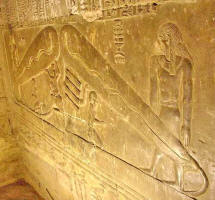 Why
on earth are the snake-stones (if that is what they are
presumed to be) attached to some sort of a cord or cable,
leading to a pedestal with Horus on the top of it in one
case, and to the djed pillar in another? The cable
depiction still bears traces of braiding—it is not a smooth cord
but very much reminiscent to modern multipurpose cables. Then
there is another mystery.
Why
on earth are the snake-stones (if that is what they are
presumed to be) attached to some sort of a cord or cable,
leading to a pedestal with Horus on the top of it in one
case, and to the djed pillar in another? The cable
depiction still bears traces of braiding—it is not a smooth cord
but very much reminiscent to modern multipurpose cables. Then
there is another mystery.
The priests seem to be wearing some
sort of goggles over their eyes (the second drawing does
not contain the people, as it is only a schematic depiction of
the objects in the scene). But if we forget the whole
snake-stones business and look at these depictions as a
representation of what they seem to imply, then certain symbols
will start making some sense. The snake symbol happens to be
very similar to the modern symbol of static electricity
and Horus represented, amongst other things, lightning.
Another matter entirely are the texts which accompany the
depiction. On the first look, they seem to support the
conclusions of the Egyptologists about the mythological
nature of the Dendera wall art. But it is known that the
Egyptians (and not only ancient Egyptians, consider the medieval
alchemy texts, for instance) used to embellish any technical
information in a mythological form to obscure the meaning
for an uninitiated reader. Many good examples of how far the
ancients went in this respect are found in The Sacred
Mashroom and the Cross, by John Allegro.
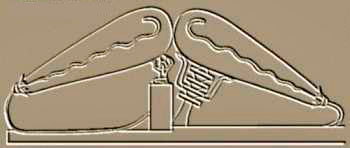
Ivan Sanderson gives an example of analysis in an already
mentioned publication, Investigating the Unexplained,
done by an electromagnetics engineer, who knew nothing about the
history or mythology of ancient Egyptians. It is necessary to
quote him verbatim for contextual meaning:
"The items, as depicted, are
most fascinating—certain elements, especially the cables,
are virtually an exact copy of engineering illustrations
as currently used. The cable is shown as very heavy, and
striated—indicating a bundle of many conductors, rather than
a single high voltage cable. As a matter of fact, a single
high voltage cable would be much thinner; if the insulation
was required to be that heavy for extreme high voltages, or
moderately high voltages at high currents, rest assured that
no technician would be holding the associated device. Corona
leakage would ’get’ him most swiftly. The supporting stands
would be much taller and heavier to withstand such voltages.
It is much more likely that the cable is, as stated, a
multi-conductor, wrapped and insulated with an outer jacket.
If this were a ’light bulb’, the maximum size of both would
be explainable by heavy current demands; but high voltage of
such a size would not be required. It would seem to follow
that moderately high voltages are in use; a connector is
obviously employed; some type of supporting base to glass
seal seems apparent.
However, the two ’bulbs’ are not identical, as shown
by the design on their sides [another depiction not
displayed here was analyzed—the snake symbol in the
first bulb ended with a s-like curve, while the other
one ended with a curve as seen in the drawings above
- Ed.] and the base stand. I do not think that they are
transparent, as the ’technician’s’ body is not visible
through the device; it would seem more obvious that these
are identifying markings, or coding (as a type number on a
TV camera tube), probably indicating use of the device.
Since the cables seem to originate at the ’altar’,
one wonders if this is a manually controlled setup, or
remotely controlled. Further, with both devices set at an
angle, and shown aimed at the wall [in the glyph, both
’bulbs’ are oriented in the same direction], could they not
be the ancient equivalent of the modern TV projection
system? One should note that the two ’technicians’,
especially the one on the left, seem to be wearing a mask
device (eye shield?); and unless the drawing is badly
reproduced, both have some sort of apparatus in their ears,
suggesting the equivalent of modern TV cameraman’s gear,
complete with radio receiver and/or earphones for direct
instructions during a ’show’.
It is necessary to acknowledge the
possibility that the devices depicted in Dendera may have
had entirely different purpose than what is suggested in the
analysis. But the recognition of an electromagnetic aspect
of the glyphs seem to fit far better than the mythological
interpretation. Of course, considering that the Dendera
glyphs have been ’explained’ predominantly during the
last century when many devices in use today were yet to be
invented, one may understand the confusion of the scholars when
trying to interpret their meaning. Thus a clear model of an
airplane has been identified as ’wooden bird’, for
instance.

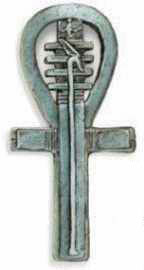 I
would like to draw your attention towards the djed pillar.
It appears in many different forms and combinations with other
devices. Because of that, I have my doubts that the function of
the pillar has been identified correctly in the analysis
mentioned above. In the most wide use, it appears as a
hieropglyph, representing the consonant ’dj’. In the
glyphs where it has discernibly a character of an object,
egyptologists interpret it as a symbol of stability and,
in some sense, that is what it well may have been when used as
an element in jewelry, for instance; but even there are implied,
in one form on another, its original functions. A typical
example is a pendant, composed of a djed pilar inside an ankh,
our already familiar Horus connecting the pillar with the loop
of the ankh. The ankh is a symbol for life, but I
am suspicious that it had another meaning, not dissimilar in its
form to that of the djed pillar. Again, the ankh form may
have had several meanings, depending on the context with other
devices. We can use as an analogy the modern
electronics schemes, in which the interpretation of any
simple symbol is apparent from the context with other symbols.
I
would like to draw your attention towards the djed pillar.
It appears in many different forms and combinations with other
devices. Because of that, I have my doubts that the function of
the pillar has been identified correctly in the analysis
mentioned above. In the most wide use, it appears as a
hieropglyph, representing the consonant ’dj’. In the
glyphs where it has discernibly a character of an object,
egyptologists interpret it as a symbol of stability and,
in some sense, that is what it well may have been when used as
an element in jewelry, for instance; but even there are implied,
in one form on another, its original functions. A typical
example is a pendant, composed of a djed pilar inside an ankh,
our already familiar Horus connecting the pillar with the loop
of the ankh. The ankh is a symbol for life, but I
am suspicious that it had another meaning, not dissimilar in its
form to that of the djed pillar. Again, the ankh form may
have had several meanings, depending on the context with other
devices. We can use as an analogy the modern
electronics schemes, in which the interpretation of any
simple symbol is apparent from the context with other symbols.
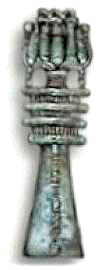 As
seen on the illustration, the djed pillar was apparently
used in many different configurations. It does not necessarily
mean that it did not have a single, specific purpose, maybe in
some way reflected in the symbolic use of it for representing
stability. The device’s function as an insulator may be a
fitting interpretation in some of the examples, but in others,
it seems to be at odds with what the depiction represents. In
several djed representations, fins on the stand below four
horizontal rings are attached. In some interpretations, one of
which is illustrated in Sanderson’s book, they are vents
for a battery located at the bottom of the pillar. There
the pillar is interpreted as a static electricity generator,
based on the configuration as follows:
As
seen on the illustration, the djed pillar was apparently
used in many different configurations. It does not necessarily
mean that it did not have a single, specific purpose, maybe in
some way reflected in the symbolic use of it for representing
stability. The device’s function as an insulator may be a
fitting interpretation in some of the examples, but in others,
it seems to be at odds with what the depiction represents. In
several djed representations, fins on the stand below four
horizontal rings are attached. In some interpretations, one of
which is illustrated in Sanderson’s book, they are vents
for a battery located at the bottom of the pillar. There
the pillar is interpreted as a static electricity generator,
based on the configuration as follows:
-
On the top of the pillar is an
ankh, with two hands-holders pointing upwards and between
their palms is a spherical object.
-
Two ’priests’, again with
goggles, are facing the object.
-
Six baboons, three on each side,
are rising in what can be described as a receptive position,
along the slope of a structure behind the device (a
mountain?), towards the sphere.
The baboons in this case may have
quite mundane meaning; it is known that priests-technicians
employed these creatures for menial jobs in the temples because
of their ’professional moronism’—they, when trained, proved to
be more reliable than humans as they lacked the human propensity
for daydreaming.
Inside the djed, as the mentioned interpretation
suggests, is an endless belt placed around two pulleys; at the
bottom the battery deposits a charge by means of electrodes of
the battery and as it moves constantly, the charge is carried to
the ankh, which is in essence a combination of a
discharge electrode and a surface spheroid (the upper loop). The
charge is built up on the spherical surface until the potential
is sufficient to bridge the gap to the sphere above. The
discharge would appear as lightning. If the charge is powerful
enough, the upper sphere may start to glow, under certain
conditions. Of course, this is just a speculation, but possibly
closer to the actual purpose of the device than some
mythological explanation.
Other interpretations of the djed pillar may be offered
based on the Dendera glyphs. If we assume that the ’bulbs’
are, in fact, electron/cathode ray tubes, it would make a sense
to interpret the pillars as some kind of ray bending device.
Based on the ’ring’ used, a different function may have been
achieved. This interpretation is suggested by the way the pillar
is connected to the tube: in one case, the tube rests on the top
of the pillar; in another the second ring is a base for two
’hands’ reaching to the tube; in a third case it’s the third
ring from the top with arms holding the tube. The rings may be,
in this case, magnets bending the ray.
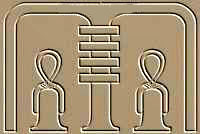 Of
all the glyphs, I consider the representation on the right one
of the most intriguing. Its symmetry was the first thing which
attracted my attention. As I looked at the drawing, I could not
leave unnoticed the way the djed pillar encloses the two
symmetrically positioned objects. The objects themselves are
strange. The loop portion resting on an omphalos reminds one of
the upper portion of ankh. Is there a connection? If there is,
then the ankh may be something different than how it has been
interpreted in the example with spheres. The more I looked at
the picture, the more the feeling that I was looking at
something conceptually quite modern gained in intensity. If we
assume that the rings on the djed are magnets (or
wiring with the function of generating the magnetic field), then
the loops placed on the symmetrically positioned omphaloses may
represent one of the two, either a stator or a rotor.
What we see here is, possibly, a very, very ancient electric
motor, albeit in a schematic form.
Of
all the glyphs, I consider the representation on the right one
of the most intriguing. Its symmetry was the first thing which
attracted my attention. As I looked at the drawing, I could not
leave unnoticed the way the djed pillar encloses the two
symmetrically positioned objects. The objects themselves are
strange. The loop portion resting on an omphalos reminds one of
the upper portion of ankh. Is there a connection? If there is,
then the ankh may be something different than how it has been
interpreted in the example with spheres. The more I looked at
the picture, the more the feeling that I was looking at
something conceptually quite modern gained in intensity. If we
assume that the rings on the djed are magnets (or
wiring with the function of generating the magnetic field), then
the loops placed on the symmetrically positioned omphaloses may
represent one of the two, either a stator or a rotor.
What we see here is, possibly, a very, very ancient electric
motor, albeit in a schematic form.
On the ankh illustration (combined with the djed in the center)
is another object—a shaft or scepter. It seems that the
combination is not coincidental: it has another meaning, albeit
the use on a pendulum would suggest a more symbolic meaning.
But if it is symbolic, then there is only one option, in the
contextual sense. All the objects—the ankh, the djed
and the staff—must be related to power, or to
express it more accurately, to a force. The ankh, for
instance, is generally interpreted as a symbol for life, but may
infer in context that something is alive. It may be a
coincidence, how an electrician would say that one of the wires
in your electric installation is live, but it is tempting to
assume that the ancients would handle certain concepts in a
similar way. What could be a better way to illustrate the
flow of a force?
The staff-scepter, before utilized by kings as a symbol of
power, was in use by gods. Logically, there would not be that
kind of attribute connected to the scepter if there were no
basis for such a connection. (It is not the purpose of this
article to identify the gods, for even if they were the
originators of the suggested devices, the subject is beyond the
preset scope.) That the staff-scepter has a connection to a
force, power, energy is ascertained in myths, which not only
originated in Egypt, but are corroborated also in
Mesopotamian and Indus Valley materials. The
gods have different names, but their attributes, that is,
devices they used, are the same. The
staff-scepter is described in all these sources as a
paralyzing device, a personal weapon of the gods when
pacifying the humans was the only way left to show who is the
boss.
(For related and detailed
information read
The Earth Chronicles)